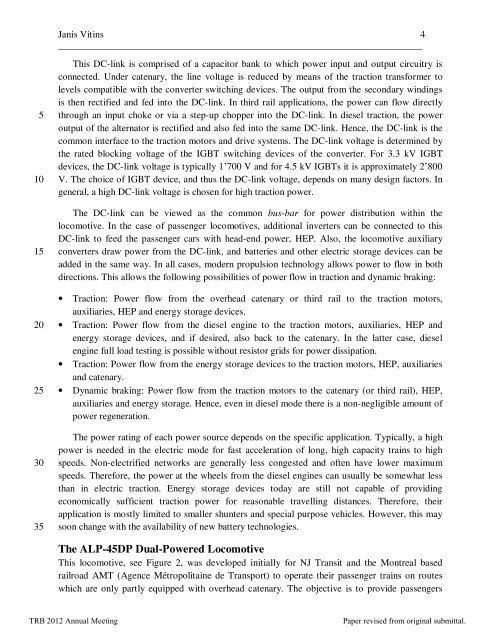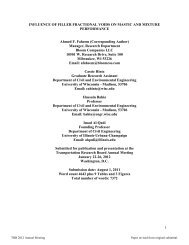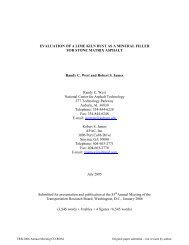DUAL MODE AND NEW DIESEL LOCOMOTIVE DEVELOPMENTS
DUAL MODE AND NEW DIESEL LOCOMOTIVE DEVELOPMENTS
DUAL MODE AND NEW DIESEL LOCOMOTIVE DEVELOPMENTS
Create successful ePaper yourself
Turn your PDF publications into a flip-book with our unique Google optimized e-Paper software.
5<br />
10<br />
15<br />
20<br />
25<br />
30<br />
35<br />
Janis Vitins 4<br />
___________________________________________________________________________<br />
This DC-link is comprised of a capacitor bank to which power input and output circuitry is<br />
connected. Under catenary, the line voltage is reduced by means of the traction transformer to<br />
levels compatible with the converter switching devices. The output from the secondary windings<br />
is then rectified and fed into the DC-link. In third rail applications, the power can flow directly<br />
through an input choke or via a step-up chopper into the DC-link. In diesel traction, the power<br />
output of the alternator is rectified and also fed into the same DC-link. Hence, the DC-link is the<br />
common interface to the traction motors and drive systems. The DC-link voltage is determined by<br />
the rated blocking voltage of the IGBT switching devices of the converter. For 3.3 kV IGBT<br />
devices, the DC-link voltage is typically 1’700 V and for 4.5 kV IGBTs it is approximately 2’800<br />
V. The choice of IGBT device, and thus the DC-link voltage, depends on many design factors. In<br />
general, a high DC-link voltage is chosen for high traction power.<br />
The DC-link can be viewed as the common bus-bar for power distribution within the<br />
locomotive. In the case of passenger locomotives, additional inverters can be connected to this<br />
DC-link to feed the passenger cars with head-end power, HEP. Also, the locomotive auxiliary<br />
converters draw power from the DC-link, and batteries and other electric storage devices can be<br />
added in the same way. In all cases, modern propulsion technology allows power to flow in both<br />
directions. This allows the following possibilities of power flow in traction and dynamic braking:<br />
• Traction: Power flow from the overhead catenary or third rail to the traction motors,<br />
auxiliaries, HEP and energy storage devices.<br />
• Traction: Power flow from the diesel engine to the traction motors, auxiliaries, HEP and<br />
energy storage devices, and if desired, also back to the catenary. In the latter case, diesel<br />
engine full load testing is possible without resistor grids for power dissipation.<br />
• Traction: Power flow from the energy storage devices to the traction motors, HEP, auxiliaries<br />
and catenary.<br />
• Dynamic braking: Power flow from the traction motors to the catenary (or third rail), HEP,<br />
auxiliaries and energy storage. Hence, even in diesel mode there is a non-negligible amount of<br />
power regeneration.<br />
The power rating of each power source depends on the specific application. Typically, a high<br />
power is needed in the electric mode for fast acceleration of long, high capacity trains to high<br />
speeds. Non-electrified networks are generally less congested and often have lower maximum<br />
speeds. Therefore, the power at the wheels from the diesel engines can usually be somewhat less<br />
than in electric traction. Energy storage devices today are still not capable of providing<br />
economically sufficient traction power for reasonable travelling distances. Therefore, their<br />
application is mostly limited to smaller shunters and special purpose vehicles. However, this may<br />
soon change with the availability of new battery technologies.<br />
The ALP-45DP Dual-Powered Locomotive<br />
This locomotive, see Figure 2, was developed initially for NJ Transit and the Montreal based<br />
railroad AMT (Agence Métropolitaine de Transport) to operate their passenger trains on routes<br />
which are only partly equipped with overhead catenary. The objective is to provide passengers<br />
TRB 2012 Annual Meeting Paper revised from original submittal.




